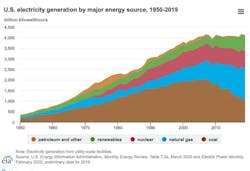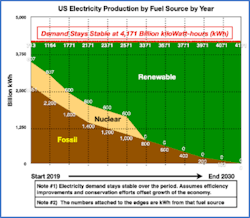A Practical Pathway for Our National Energy Future: Part 3
Reducing carbon output from the American power grid is an essential goal, meriting urgent and committed attention. However, while accelerating the growth of low-carbon technology on the current U.S. grid for decarbonization is laudable (suggesting that all changes could be made within 10 years), it is currently impractical and enormously risky. Part 1 and Part 2 of this five-part series introduced the grid at the edge, the dangers of a 10-year timeline, and how to achieve a low-carbon renewable energy power system. Part 3 discusses the transition to distributed energy resources (DERs), the shift from an old paradigm to a new paradigm.
How to Realize a Paradigm Shift
Successfully achieving the energy objectives of any form of the Green New Deal (GND) depends upon the ability to deliver clean energy in a stable, secure, and resilient manner. The new grid would supplant the current grid and be capable of accommodating a vastly different mix of generation sources. Moreover, the geographical dispersion of generation resources may be much different. The new grid is the core of a successful paradigm shift.
Realizing this paradigm shift demands extensive design, engineering, major procurement, and massive construction. Moreover, this effort includes widespread modification of the associated computer support systems and the creation of new distributed energy resource management systems (DERMS). Because the existing grid is a product of many decades of effort and huge expenditures, building the new grid will be extremely costly (estimates need more design and planning details, but costs would likely exceed a trillion dollars) and will take longer than the currently proposed 10-year target. This statement considers the fact that the current system took more than 100 years to evolve.
As presented in Part 1, the current 10-year proposal would likely create unintended and harmful side effects to the power system. To deal effectively with the energy objectives of a practical system to minimize carbon dioxide (CO2), a successful solution requires collaborative and careful development. It will take significant time to new develop the engineering standards and the associated design, let alone fully implementing the new grid. An effective new grid is central to a functional energy decarbonization program.
As an engineer, my approach to problem-solving employs a systems approach. This approach defines an objective (purpose) before starting the analysis and then sets boundaries encompassing the elements contributing to or detracting from an optimum solution. Technically this approach has been successful for me and many others. Aside from using this effective problem-solving technique, though, to achieve the best results, it is essential to develop effective interpersonal relationships among stakeholders who may or may not support the objective. In my experience, an optimal approach tends to blend systems analysis with the human side of the equation.
For the new grid solution to be optimal, stakeholders must include consumers, numerous governmental and regulatory entities, economists, environmental groups, suppliers of power generation, transmission and distribution (T&D) products and services, and potential commercially interested parties. Special interest groups (lobbyists) representing the foregoing entities will no doubt interject themselves, which typically complicates the solution.
Managing stakeholders effectively requires clear communication of expectations. Managing those expectations requires mediation experience as well as technical skills. Sound leadership from industry and engineering sources (versus governmental agencies) is key to determining the success of this endeavor. To increase the chances of building trust in the system, "must-have" and "no-go" wishes should also be made clear by all involved parties.
The enormity of this project demands legal and regulatory support as well as funding from state and federal governments, investors, and ratepayers. Successfully developing and executing the program requires significant technical support from consortiums of industry and university experts, in cooperation with international specialists. Engineering societies such as the Institute of Electrical and Electronic Engineers (IEEE), the American Society of Mechanical Engineers (ASME), and the American Society of Civil Engineers (ASCE) could provide collaborative solution platforms for developing design fundamentals and project plans.
Proponents of the GND proposal are, at least partially, basing the 10-year time constraint on the recent UN Intergovernmental Panel on Climate Change (IPCC) report. I am an electrical engineer, not a climatologist, but I understand that there are reputable climate scientists and experts who dispute some of the methods, findings, and claims used to develop the report. Consequently, despite the IPCC report, the 12-year apocalyptic deadline may remain open to debate and deadline advances because of the technical improvements of a new grid.
I am not a "climate denier" and I fully support the importance of improving climate by reducing the carbon generated by energy production as quickly as possible using a "no regrets" approach. I am, however, very concerned as to how the project management constraints of a 10-year completion target and the stringent energy resource constraints espoused by the proposed GND could unintentionally sabotage the outcome of a decarbonization program. The unintended consequences of a hurried implementation of a poorly thought out power system transformation plan could create devastating outage risks, as explained in the Risk Highlights section in Part 1 of this series.
Alternatively, a well-designed and sensibly implemented carbon remediation plan, integrated with a new grid, may amend the 'inevitability' of the dire 12-year prediction of the IPCC report. Given the technical and financial resources of the United States, the design and implementation of the new grid could serve as a model for other countries to decarbonize. This approach could consolidate resources, minimize "reinventing the wheel" and develop global templates for design, engineering, manufacturing, construction, and implementation standards. This approach could help define a global method of climate improvement vis-à-vis common-sense carbon reduction using effective project management.
The generation attributable to the predicted GND generation by fuel from 2019 until 2029 is depicted in Fig. 2. The chart consolidates coal, natural gas, and petroleum — displayed in the chart as Fossil. This figure also consolidates all forms of renewable energy (solar, wind, wave, hydro, geothermal, bio-derived fuels, and so forth) and depicts them as Renewable. These resources can be characterized as DERs. Going forward, to satisfy the growing renewable energy requirements of the proposed GND, solar photovoltaic (PV), wind, and bio-derived and hydrogen energy systems must increase dramatically.
By 2029, the proposed GND generation plan intends to replace the current non-renewable energy sources (petroleum, natural gas, coal, and nuclear) entirely with renewable energy. The renewable energy resources would consist solely of renewable DERs. To aid in controlling the grid, the renewable energy resources will be supported with battery energy storage systems (BESS) and inverters. For purposes of simplicity, Fig. 2 assumes that efficiency improvements and energy conservation efforts offset generation increases because of economic growth. Moreover, the increase in the use of electric vehicles (EVs) will impact both the energy requirements and the time of day at which those demands are needed. However, EVs include hydrogen vehicles, so the load service for these vehicles is considered part of renewable energy. Consequently, for purposes of simplification, Fig. 2 assumes a continuing and fixed generation requirement of 4171 billion kWh.
In Fig. 2, nuclear power phases out by 2025. Phasing out nuclear power is a complex process. This effort requires intricate decommissioning practices as well as challenging fuel and waste disposal procedures — all of which must comply with the applicable sections of the Code of Federal Regulations. The loss of this (almost) carbon-free source of energy creates a large gap to be filled by renewables. The nuclear loss magnifies the challenges of quickly satisfying the renewable energy deficit. Slowing the reduction of nuclear generation would reduce the implementation pressure placed on the new grid implementation without significantly deferring carbon reduction. Moreover, given recent advances in nuclear technology, eliminating existing nuclear energy is a concept that deserves more careful evaluation before proceeding.
According to the U.S. Energy Information Administration, as of Dec. 31, 2017, there were about 8652 power plants in the United States that had operational generators with an individual nameplate electricity generation capacity of at least 1 MW. A power plant may have one or more generating units and some power plants may use more than one type of fuel. The GND proposes replacing all those power plants with renewable energy capacity by 2030.
Renewable DERs would be composed of many large and medium-sized solar and wind energy as well as hydro sources, integrating with a huge number of consumer-based smaller solar energy and other independent microgrid resources (industry, commercial, battery, and hydrogen resources). Even with the introduction of storage (hydrogen and batteries), the outputs of DERs are more difficult to manage because of the vagaries of sunshine, wind availability, and wind strength. The new grid system must include DERMS to control and protect the new DERs.
Without a new grid, the absence of large easily controllable central power plants to balance power flows, coupled with the undependable power output and difficult controllability of many of the DERs would encumber the NERC's ability to ensure the reliability and adequacy of power supply. To satisfy current power regional generation requirements, the number of large DERs would need to exceed the number of large central power stations. These new DERMS would need the ability to control the large matrix of DERs. This controllability is a key operational success factor of the new paradigm.
Protecting system performance from malicious computer interference is another ongoing crucial task. To prevent significant blackouts and system perturbations, all the foregoing tasks must be done successfully under normal and abnormal (for example, weather extremes or malevolent disruptions) circumstances. The enormous changes proposed by the GND in a 10-year timeframe invite power system chaos, not just significant blackouts and system perturbations.
In Part 4 of this five-part series, the author will describe the overall operation of the current power delivery system and propose what will be required on the new grid at the edge to dispense renewable DERs.
Technical Acknowledgements
The author would like to thank the following colleagues for offering encouragement, comments, and review of this article. Their help was technical and editorial in nature and does not imply their endorsement of the concepts that the author describes. The views and opinions included within the article are those of the author and may not reflect those of the editors or any other person or entity that contributed to this article.
- John Gentile – Director of Cascadia Energy Technologies, LLC
- Daniel Udovic, PhD-EE, PE – CEO of Processor Innovations
- Dan Madden, PE – CEO of Eco Energy International
- Nasser Jaleeli, PhD-EE, PE – CEO of Priority-based Control Engineering
- Michael Heyeck, PE – Founder, The Grid Group, LLC
- Tim Lowe, PhD – VP of Eco Energy International
- Harry MacCormack, MFA – Board member of Ten Rivers Food Web
- Bernie Gagliano – Independent consultant and information architect
- Joseph Sperry, PhD – Co-founder, S4 Consultants
About the Author
Thomas A. McClimans
Thomas A. McClimans, P. E. is a director of Cascadia Energy Technology in Corvallis, Oregon. He has been enjoying a more than 45-year career in power generation (O&M), power plant construction, and computer control systems. Early in his career, McClimans implemented a groundbreaking direct digital control (DDC) system at an 800-MW coal-fired, super-critical generating unit at the Conesville Power Plant. He later became the youngest plant manager at Conesville, which was a 2000-MW generating station with over 600 employees and an annual budget in excess of US$150 million.
Since then, he has held senior level management and engineering positions in both domestic and international markets, working for such firms as American Electric Power (AEP), Black & Veatch International (BVI), NRG and TECO Power Services. Project responsibilities include EPC management, IT project management, O&M management, and generation portfolio management.
His assignments include some of the most challenging electric generating projects in the world. For example, as director of engineering computer applications for the AEP, he directed developing and implementing the computer control system for the AEP transmission grid and also implemented enterprise asset management systems for the AEP's fossil and nuclear generating plants.
Working as general manager for the BVI, he directed a generation optimization project for the 5000-MW Saudi Consolidated Electricity Co. in Jeddah, Saudi Arabia. Also working for the BVI, McClimans successfully directed redesigning and optimizing a waste-to-energy power plant in the United Kingdom and then managed several EPC projects in Thailand. Working as task manager for BVI-USAID, McClimans managed a project to help restore generation in Afghanistan. Working as general manager for NRG and TECO Power Services, he managed a multistate merchant power plant portfolio based on coal-fired boilers and gas-fired CCTs.
McClimans earned a BSc in electrical engineering from Ohio University. He is a registered professional engineer in Ohio and a life member of Institute of Electrical and Electronics Engineers (IEEE).


